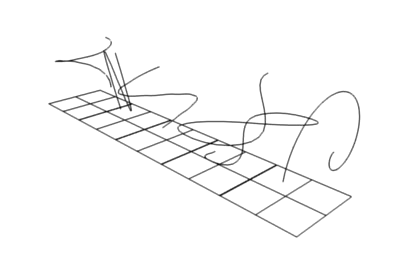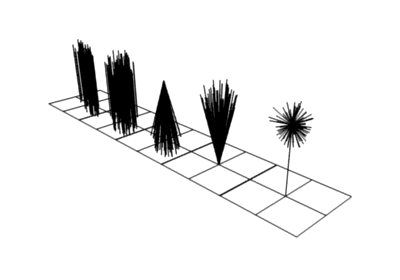Children
Reference
- Panel
Children are Hair or Emitter particles originating from individual particles. They make it possible to work primarily with a relatively low amount of Parent particles, for whom the physics are calculated. The children are then aligned to their parents. The number and visualization of the children can be changed without a recalculation of the physics.
If you activate children, the parents are no longer rendered. This can be enabled in the Render panel Parent Particles. By default, parent particles are not rendered because the shape of the children can be quite different from that of their parents.
Common Options
- Child Type
- None
No children are generated.
- Simple
Children are emitted from the parent position.
- Interpolated
Children are emitted between the Parent particles on the faces of a mesh. They interpolate between adjacent parents. This is especially useful for fur, because you can achieve an even distribution. Some of the children can become virtual parents, which are influencing other particles nearby.
- Display Amount
The number of children in the 3D Viewport.
- Render Amount
The number of children to be rendered.
- Length
Length of child paths.
- Threshold
Amount of particles left untouched by child path length.
- Seed
Offset in the random number table for child particles, to get a different randomized result.
Clumping
Reference
- Panel
- Use Clump Curve
Use Curve Widget instead of parameters.
- Clump
Clumping amount along child strands. The children may meet at their tip (1.0) or start together at their root (-1.0).
- Shape
Form of Clump. Either inverse parabolic (0.99) or exponentially (-0.99).
- Twist
Todo.
- Use Twist Curve
Todo.
Clump Noise
Creates random clumps around the parent hair.
- Clump Noise Size
The size of the clumps.
Roughness
Reference
- Panel
- Use Roughness Curve
Use Curve Widget instead of parameters.
- Uniform, Size
It is based on children location so it varies the paths in a similar way when the children are near.
- Endpoint, Shape
"Rough End" randomizes path ends (a bit like random negative clumping). Shape may be varied from <1 (parabolic) to 10.0 (hyperbolic).
- Random, Size, Threshold
It is based on a random vector so it is not the same for nearby children. The threshold can be specified to apply this to only a part of children. This is useful for creating a few stray children that will not do what others do.
Kink
Reference
- Panel

Child particles with Kink.
From left to right: Curl, Radial, Wave, Braid, Spiral.
With Kink you can rotate the children around the parent. See Fig. Child particles with Kink. above picture for the different types of Kink.
- Kink Type
- Nothing
Deactivated.
- Curl
Children grow in a spiral around the parent hairs.
- Radial
Children form around the parent a wave shape that passes through the parent hair.
- Wave
Children form a wave, all in the same direction.
- Braid
Children braid themselves around the parent hair.
- Spiral
Generates a spiral at the end of each hair.
- Radius, Resolution
Define the overall size.
- Shape
Makes a the spiral grow in- or outward.
ملاحظة
Alignment Limitations
When hair is pointing straight up (along the chosen spiral axis, default Z), spirals may not show up! This is a limitation of the projection method used. Giving a slight tilt or random orientation to hairs fixes this.
- Amplitude
The amplitude of the offset.
- Clump
How much clump effects kink amplitude.
- Flatness
How flat the hairs are.
- Frequency
The frequency of the offset (1/total length). The higher the frequency the more rotations are done.
- Shape
Where the rotation starts (offset of rotation).
Simple
- Size
A multiplier for children size.
- Random Size
Random variation to the size of child particles.
- Radius
The radius in which the children are distributed around their parents. This is 3D, so children may be emitted higher or lower than their parents.
- Roundness
The roundness of the children around their parents. Either in a sphere (1.0) or in-plane (0.0).
Interpolated
- Virtual Parents
Relative amount of virtual parents.
- Long Hair
Calculate children that suit long hair well.
Parting
- Parting
Creates parting in the children based on parent strands.
- Min/Max
The minimum/maximum root to tip angle (tip distance/root distance for long hair).
Example

From left to right: Round: 0.0, Round: 1.0, Clump: 1.0, Clump: -1.0, Shape: -0.99.